
Are Egyptians ancestors Indian in origin
In my previous article, I discussed on the cult of lord Krishna being worshipped in Egypt as Deity ‘amun’. I symbolically compared Egyptian Opet festival with Indian rath yatra festival. In this article, I will be discussing the origin of Opet festival in more details by establishing the link between ancient Egypt and India.
Egyptians ancestors came from Land of “Punt”
Egyptians themselves said that they can from the land called 'Punt', the land of gods. Egyptians believed their ancestors came from a land called ‘Punt’. Mention of punt can be found in plarmo stone belonging to the reign of king Sahure(2500 BC). Here, it talks about expedition to acquire incense, ivory, wood for religious rituals, in which thousands of men were involved. Detailed description of the Punt expedition is found in Hatshepsut's mortuary temple, thebes. These descriptions talks about queen Hatsheptsut’s expedition to be headed by her Chancellor Senmut, on a fleet of five ships.
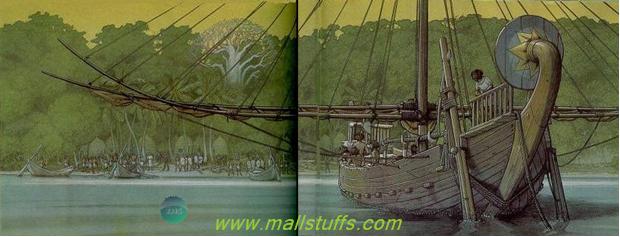
Egyptian ship model
Warmly welcoming them , king parahu and queen ati laden their ships with tones resin, woods, gold, spices, ebony, cosmetics, incense, pure ivory, along with animals like apes, dogs, monkeys, skins of the panther ( as garment for Egyptian preist), along with natives. This inscription says the expedition travelled south east to Egypt and crosses the red sea. Further, it is said that the whole journey through the great ocean is very dangerous and takes as long as three years for the expedition to return back.
Punt is in India
Below is the point which makes India, the best choice for punt.
1) In Google maps, if you look south east to red sea then all you find is Indian Ocean and no country except countries of Indian subcontinent. So, most probably, punt should be somewhere in India.
2) According to Egyptians text, Punt means ‘Land of the gods’. Now in ancient times, there were very few civilizations with many gods and predominant among them were Greek and Indians. Greek cannot be punt because there is no need to cross the red sea nor the commodities like ivory, rhino horn, spices etc can be found in Greece. So, again it is India who suits the title "land of ‘punt’". It is a well known fact that India has many gods and as per the estimates, India has more than million gods and goddesses.
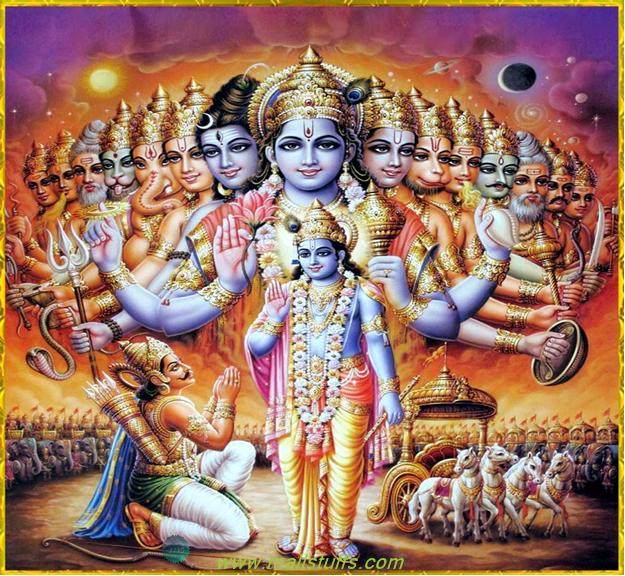
Millions of gods in Lord Krishna Vishwa-Roop Darshan
3) Punt means land of the gods. From this meaning, I can derive Indian city ‘Puri’ as ‘Punt’.
In India, sages have been considered as an incarnation of god and according to scriptures, serving Brahmin sages is equivalent to serving god. Mahabaharat says lord Krishna served sage Ved vyasa and his guru sage ‘Sandipani’ while ramayaa says lord rama served sage ‘Vasistha’. Sage is called ‘sant’ in Sanskrit. Sant also mean ‘God’. ‘Puri’ is land and ‘sant’ is God. Combine the two words puri and sant. What do you get? Yup we get the word “Punt” and its meaning ‘Land of the gods’. Note that Puri has been the top most spiritual city since time unknown but predates the Indus valley period. It is also one of the four sacred places (Char Dham) of Hinduism. Also, relate the festival of rath yatra being copied in Egypt as ‘Opet festival’.
4) Puri is located in Indian state of Orissa. Orissa is abundant in natural resources. Many of the world's top mineral resources companies like posco, Vedanta, arcelormittal operates in Orissa. Further you will find all other commodities listed in queen Hatsheptsut’s expedition. Rhino horn can be found in neighboring states of ‘Assam’. Monkeys, panther, apes and other animals can be found in Orissa itself. Spices are the major commodity of Orissa. When I visited the JagganathPuri temple in 2003, I remember buying the spices from the market situated next to Unesco world heritage site konark(Sun god) Temple.
5) According to Egyptian scriptures, queen Hatsheptsut expedition faced a daunting and difficult task of crossing the great ocean and their journey took as long as three years. Next to Egypt, the only great ocean I can see is Indian Ocean. No Doubt venturing in the open Indian Ocean is a daunting and difficult task. Distance between Egypt and ‘Puri’ along the sea route of srilanka is almost 10000 kilometres.
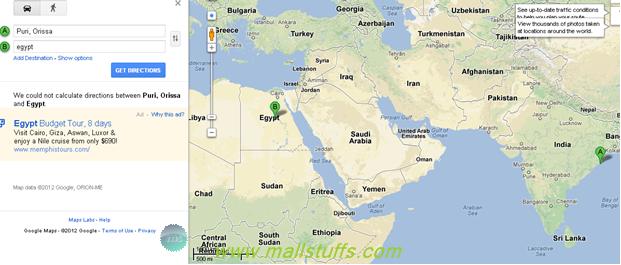
Puri (A) and Egypt (B) from Google maps
As per the Egyptians ship model, they must be travelling at the speed of 25-50km/hr. Since the maximum time span of their journey is 3 years, I will calculate using the minimum speed. Dividing 10,000 by 25, I get the number of days as 400. Multiplying 400 by 2(Return journey), I get 800 days which is almost 2 years 3 months. Now I can safely assume the remaining time must be their period of rest or visiting cities in Indian sub continent. Further, I think, they stopped at different shores of India to get their commodities. For Ex they must have stopped at Kerala for their world class spices.
6) One horned rhino is indigenous to India and is found only in north eastern India. Only Indians had the tradition of making ivory from elephant tusks. Orissa has abundance of elephants which has been used by kings of many empires like the gupta and Maurya Empire. This again makes ‘Puri’ as punt.
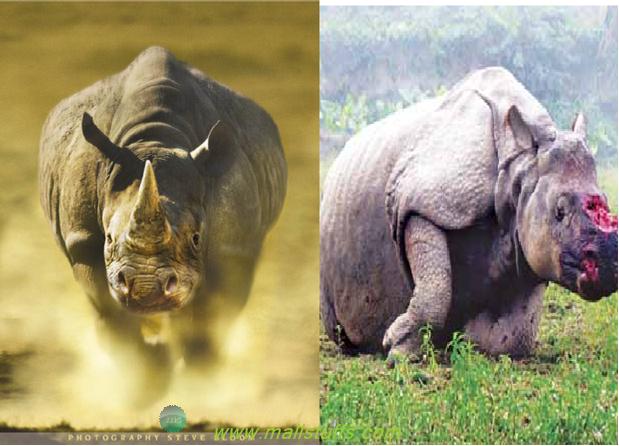
Left (One horn rhinoceros of Assam), right (Horn cut by poachers for medicine)
I was quite surprised that the historians thought Punjab, Indus valley, Kerala, Somalia and even America as ‘Punt’ but never thought of sacred city Puri as ‘Punt’. I guess these foreign historians were not aware of the rath yatra festival of Puri and its similarities with deity Amun and Opet festival. One point I forgot to mention in my last article was the exact similarities between lord Krishna with amun and khonsu with balarama. Check the below image. Lord Krishna (Extreme right) and amun both are believed and shown as black in colour while khonsu and balarama)Left of right image) both are claimed to be fair in color whereas subhadra is of the same color as ‘Mut’.
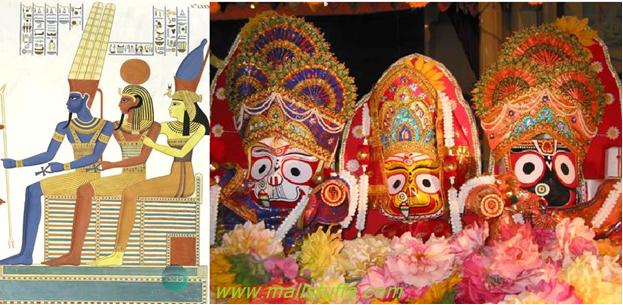
In addition to these evidences, the fact that the Egyptians had built a canal from the Nile to the Red Sea implies a considerable volume of trade toward the south and east.
More evidences were found in the cranial remains in pre-dynastic Egypt. Cranial Study of 59 skulls excavated at badari concludes that these skulls differs from native Africans and resembles closely with Indian Aryans and Dravidians. This study was further supported by two another studies done by berry and berry in 1972 and loring blace in 1993. They both declared similarity with Europeans and Vedic Indians but not at all with western Asia, sub-Saharan Africa, Oceania, or the New World
One more evidence is the inscription on the wall of queen Hatsheptsut mortuary temple at Deir el-Bahri. She mentions that she had compiled the wish of the god Amun-Re, her father, to have a grove of myrrh trees “for ointment for the divine limbs”. She says: "I have hearkened to my father...commanding me to establish for him a Punt in his house, to plant the trees of God's Land beside his temple, in his garden”. India is well known for Ayurveda, an ancient medicinal science using herbs and plants for making medicines. Ayurveda also has the technique of making ointment from myrhh leaves.

Some of the Ayurvedic products made of myrrh
Also myrrh (locally called as “Dhoop”) is used widely in India for religious rituals and poojas. You will find myrhh in shops, roadside stalls, temples etc.
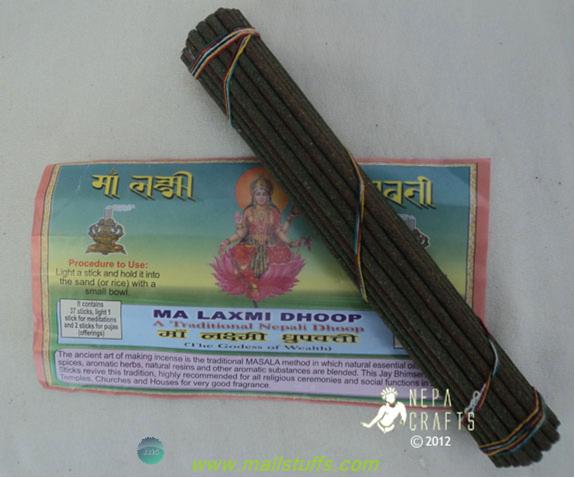
Incense sticks made of Myrhh
This clearly shows that Egyptians ancestors were Indian in origin which raises the doubt if pyramid and sphinx were constructed by Indian invaders.
A big round of applause to the original writer and also to me, for extending his research.

Enough of clapping..Let's get back to work
Dr. H.R. Hall, thought referred Punt to some part of India, Dr. H.R. Hall, an acclaimed historian said “The Indus Valley civilization is, according to Sir John Marshall who was in charge of the excavations, the oldest of all civilizations unearthed (c. 7000 B.C.) It is older than the Sumerian and it is believed by many that the latter was a branch of the former. “
Col. Henry Steel Olcott, a former president of the Theosophical Society said
“By the pictorial hieroglyphic inscription found on the walls of the temple of the Queen Haslitop (Hatshepsut) at Der-el-babri, we see that this Punt can be no other than India. It is testified by Herdotus, Plato, Salon, Pythagoras, and Philostratus that the religion of Egypt proceeded from India. For many ages the Egyptians traded with their old homes, and the reference here made by them to the names of the Princes of Punt (King Parahu and Queen Ati) and its fauna and flora, especially the nomenclature of various precious woods to be found but in India, leave us scarcely room for the smallest doubt that the old civilization of Egypt is the direct outcome of that the older India." The intention of Hatshepsut to expedite the land of Punt was to import incense, flowers, sacred and exotic goods, so as to offer these goods to deity Amun. Hatshepsut may have thought offering the goods from the land of his forefathers, and also the place from where the Amun originated, she would be doing a great deeds and service not only to deity Amun but also to his forefathers, and thereby eligible for their power, blessings, benediction and good fortune.”
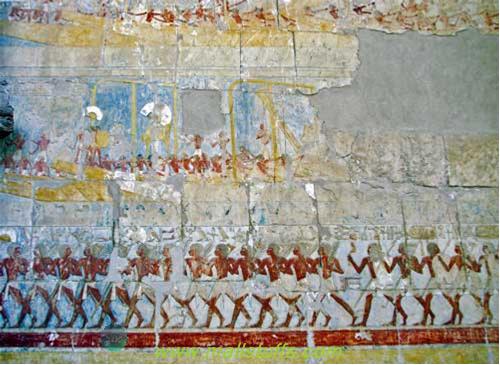
A boat procession of Deity ‘Amun’ at Hatshepsut’s temple, Deir el-Bahri
Dr. Adolf Erman declares Punt as 'a distant country full of valleys, precious metals and stones, washed by the great seas, incense, balm, rich in animals, long tailed monkeys, cheetahs, panthers, dog-headed apes, winged creatures with strange feathers to fly up to the boughs of wonderful trees, especially the coconut and the incense trees.'
There are many other scholars who believe Somalia, America or some other country as ‘Punt’ but none of these countries fits to the detailed inscriptions found in temples of Egypt nor have these scholars provided any solid evidences to prove their claim.
Actually whatever is mentioned in Egyptians scriptures can be found in Indian sub continent. Egyptians also said that their forefathers were the most civilized, spiritually advanced and the greatest of all civilization. With the discovery of dwarka, India has been regarded as the greatest advanced ancient civilization. So again punt should be India.
It should not be surprising that punt is Indians since many scholars have accepted Ethiopia to be colonized by Hindu traders. Ethiopia, as is universally admitted now, was colonized by the Hindus. Sir William Jones, an Anglo-Welsh philologist and scholar said: "Ethiopia and Hindustan were possessed or colonized by the same extraordinary race."
Ethiopian tradition says their origin coming from a land located near mouth of river Indus, confirmed by the testimony of Philostratus and Eusebius. While researching about Deity amun and opet festival of Egypt, I found another link with India. I will first start with the story of Egypt invasion.
Egyptians were living peacefully and happily under the leadership of pharaoh until the end of eighteenth century BC. Then the tyrant, irreligious, cruel invaders known as hyskos(meaning foreign rulers) invaded Egypt during 1700 BC. They burnt Egyptians cities, destroyed temples, captured women’s and children’s as slaves. In this difficult times of suffering, Egyptian retreated south in the neighboring kingdom of Kush (Nubia), known as “Ethiopia” and “Sudan” today. To gain favor of Kushites, pharaoh king ahmose married Nefertari, the black princess of Kushites.

Nefertari, the black princess of Kushites
She was of a very dark complexion, and was the most venerated woman in all of Egyptian history. With the financial and military help of the Kushites, Egyptians defeated Hyskos and threw them out of the country after 200 years in 1550 BC. After their victory, pharaohs Kamose and Ahmose venerated deity ‘amun’ as the supreme god of the state. Huge statues and temples of Amun were constructed in Karnak and Luxor. Since Egyptians and Ethiopians fought under the banner of deity amun, cult of amun spread widespread and dominated all the other gods of the Egyptian pantheon.
When I first heard about Kushites, the first thought that came to my mind was "is this the caste I belong to". I research about Kushites and found that they indeed had the Indian link. In India, this caste is known as kushwaha and can be found in states of Bihar, Uttar Pradesh, Madhya Pradesh, Orissa, Rajasthan and Gujarat. In Rajasthan and Gujarat, this caste is known as Kachwaha. Actually, kushwaha/Kachwaha claims themselves to be the descendants of Kush, son of lord Rama and hence, the descendants of sun dynasty. There are many further divisions (Sub-caste) in kushwaha caste. Section of kushwaha race that belonged to the great Mauryan Empire call themselves as ‘Maurya’. Incidentally, I found that my clan also belongs to the maurya dynasty. Other sub castes in kushwaha caste are Koeri, Kachhi, Murao etc
Section of mighty Himalayas situated near the fertile areas of Indus, Ganges and other major river is known as Hindu Kush mountain range. Hindu refers to term sindhu (Sanskrit name of river Indus) and Kush refers to Kush, son of lord Rama and hence to Kushites of Ethiopia. Just like native of India is called as Indians, native of America is called as Americans; native of hindu-kush terrain was called as Kushites in Arab world. Kushites are none other than the citizens of ancient Indus-Saraswati Civilization.
These Kushites were very skillful and fierce warriors and are probably related to the Kushan E mpire which controlled more or less whole of Indian subcontinent in 1st century AD. 
Chandragupta maurya and King Ashoka- the great are the supreme examples of the valiant and courageous warriors belonging to the Kushites/Kushwaha race. Kushites attacked Babylonia in the 9th year of Samsuiluna, the son of Hammurabi. Subsequently, they capture Babylonia in 1600 BC and ruled it for almost 400 years. Kushites most primeval deity was Suriash (Sanskrit Surya) and as I said above, Kushites were the descendants of the sun dynasty and so no doubt, they worshipped sun god. Other deities included Maruttash (Sanskrit Marut) and Indas (Sanskrit Indra, lord of heaven). Kushites kings favored diplomacy and forged alliances with kingdom of Egypt, alam, hitties etc. They introduced advanced technologies, spirituality, and brought in the Vedic customs and traditions into Africa. Kingdom of kushittes is regarded as an extension of vedic civilization.
The migration of the Kushites from the Indus Valley to the Nile, sometime around 2700 - 2500 BC, or even earlier, as a result of the cataclysmic events in the Indus Valley post the disappearance of saraswati river. These kushites migrated westwards in search of amighty river and kept on migrating until they found the mighty river Nile. They finally settled on the banks of river Nile and surrounding areas.
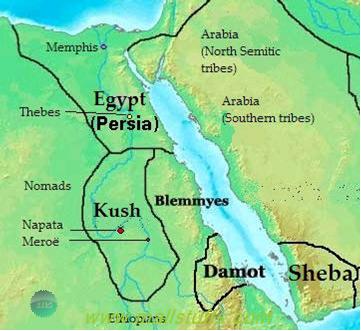
Map of Africa in 400 BC. See the nile river flowing through Kush empire.
These migrated Ethiopians (Kushites) were highly civilized, pious, and virtuous. Apollonius, a philosopher from the 1st century BC, in a conference told that “southern Ethiopians praise Indian civilization very much". Apollonius in a way mocked Ethiopians by saying, "You praise Indians so much without considering the fact you are Indians yourself”. Nilus, the Egyptian philosopher informed that, “the Vedic Indians are the most intelligent and knowledgeable of all mankind and Ethiopians are a part of that civilization and resembles them very closely”. Britannica Encyclopaedia confirms that: “All the philosophers and historians say Ethiopians of dual race, one in native Africa and another in India”. Even Mahabharata says the Bharat (India) empire to be extended upto the mlechha country. Mlechha meaning uncivlised, was referred as race beyond the Indian subcontinent (i.e Beyond Persia). Those day, Indian subcontinent included Pakistan, Afghanistan, parts of iran and Myanmar, Thailand upto Indonesia in the south, thus roughly covering an area of 1.2 million sq. km.
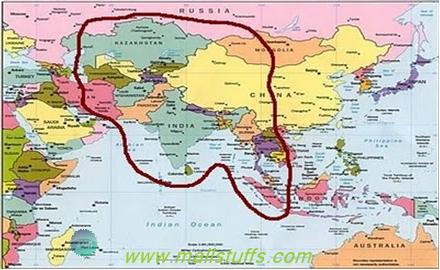
Above map shows the portion of the world covered by legendary ruler “bharat”.
Even today, Ethiopian culture, compared to rest of Africa, resembles closely with cultures and tradition of India. Caste system, vegetarian diet, spicy food, dress, jeweler, rich classical music all reflects the rich cultural heritage of India.
Sumerians called Kushites as “Meluha-Kasi”. Interestingly, residents of ancient Indus-saraswati civilization were also called as “Meluha” (or Mehluha Malaha, Meluhha) by Sumerians. Sumerians texts belonging to Akkadian king Sargon confirms extensive trade relations with its neighboring countries which includes Meluha. Further, Meluha is described as the land of exotic and sacred commodities. All this evidences is enough to prove Kushites as native of the Indus-saraswati civilization.
One of the book commissioned by Unesco “History of civilizations of Central Asia” which was attended by scholars of more than thirty countries including India, Pakistan, Iran, turkey, Russia, china , USA, UK, etc concludes the, “invasion of Babylonia by the Kushites - and their connection with the Proto Indians of Indus-saraswati civilization.” Further, linguistics terms of Kushites is said to be strikingly similar to Sanskrit. It also says that Kushites were chariot and horse warriors.”
Horse has a very close relationship with kushwaha race in india. Ramayana speaks about the Luv -kush, son of lord Rama, Capturing sacred royal horse of lord rama. In the subsequent battle, they defeated the armies of lord rama including his three brother lakhsman, shatrughan and bharat who arrived at the scene on their horse chariots. This episode clearly depicts lord rama as horse warrior and hence Kushites as horse warriors.
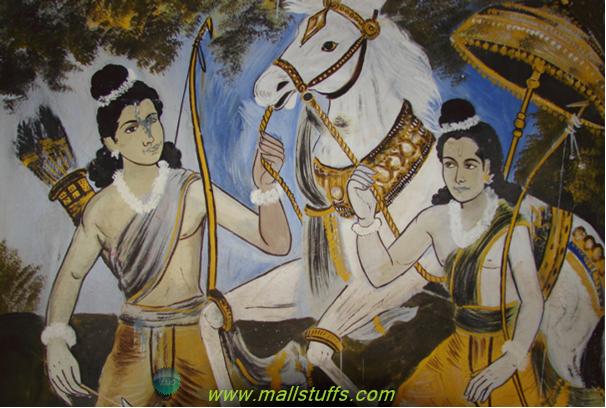
Luv and kush holding a royal horse.
In addition to kushites, hitties and mittani are supposed to be of indo-Aryan vedic race. Their major deities included Mitra, Indra, Varuna, and the Nasatyas. There is lack of evidences of these two tribes. However, Kushites warriors left their footprint all over Central and West Asia. Many cities and towns were name after them- Kussara, Kashan, Kissia, Kossea, Kashmir, Kashband, Kashgar, Kashi etc. Jacob Bryant his book An Analysis of Ancient Mythology says: "Kushites sent out their warriors and because of their scientific advancement and courageous warrior skills; they defeated many nations including Babylonia. They mixed with locals by adopting their culture where the locals accepted them and in other places, they threw away the natives and ruled solely and separately”. However, many western historians seem to be neglecting the contributions of the Kushites in ancient world. Editor of book “In the History of civilizations of Central Asia”, Vadim Mikhailovich Masson writes, “In the present writer’s opinion recent research tends to underestimate or even to deny the role played by Proto-Indians in Mesopotamia in general and in the Mitanni kingdom in particular.”
However, we can conclude the might of Kushites. They initially conquered Babylonia and Sumerians (Mesopotamia) to reach the southern part of the Arabian Peninsula. There they found kingdoms like Sheba (present day Yemen), before crossing the red sea and finally settling in the kingdom of Kush which stretched from Ethiopia to Sudan. David Gibson says “the descendants of Kush may have split, one part remaining in Asia, the other migrating to Africa to become the Ethiopia we still know to this day”.
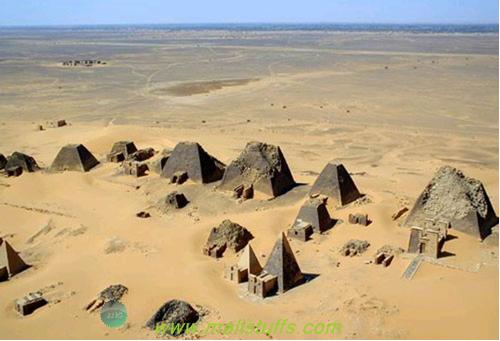
An aerial view of the Kushite pyramids at Meroe
Orientalist Edward Pococke applaud this long travel of the Vedic Indians from their motherland river Indus to fertile plains of nile as "At the mouths of the Indus dwell a seafaring people, active, ingenious, and enterprising...these people coast along the shores of Mekran, traverse the mouth of the Persian Gulf, and again adhering to the sea-board of Oman, Hadramant, and Yemen (the Eastern Arabia), they sail up the Red Sea; and again ascending mighty stream that fertilizes a land of wonders, found the kingdom of Egypt, Nubia and Abyssinia.”
Many historians claim Africa to be the cradle of human civilization while some consider india to be the cradle of human civilization. Buy they forget to consider the fact that millions of year ago, Africa and India belonged to the same plate and hence were one and the same and this is the reason why the DNA of many native Africans matches with Indians. Due to continental drift, Africa drifted away from India and they lost much of the cultures associated with India. Just like Pakistan, Afghanistan, Myanmar, Bangladesh, Cambodia, Thailand was once part of India, Africa too was part of India millions of years ago.
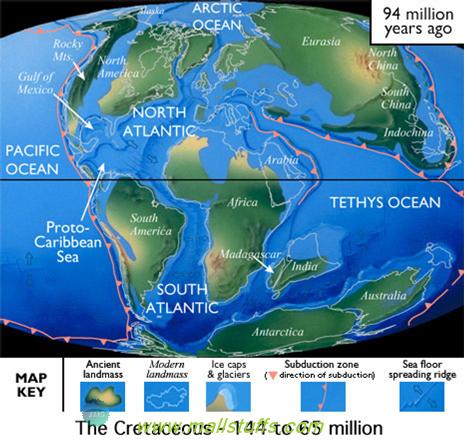
Above image shows present India to be very close to both South Africa and china. Few more millions of years ago, India was joined to Africa. Indian scriptures mentions about various yugas, ice ages, earthquakes, destruction, creation etc which is the proof of Indian civilization being the cradle of human civilization. I will come up with the series of articles on this topic once I am done with the research.
All the above facts are true to my knowledge, well supported by views of acclaimed historians and scientists. There are many other proofs of Egyptians and Africans cultures coming from India which I shall take up in my coming articles. I find it very difficult to do my research on weekends, after doing a hectic task of software development on weekdays. In spite of being a movie fan, I spend most of the time doing my research rather than watching movies these days. So, I expect you to support and appreciate the efforts I put on my articles.
Jai shree Krishna
References:
<https://bibhudev.blogspot.in/2012/01/journey-of-jagannath-from-india-to.html>